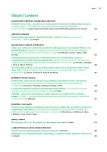Metabolic syndrome and the role of the polypill in the prevention of its complications
Authors:
Hana Rosolová
Authors‘ workplace:
Centrum preventivní kardiologie II. interní kliniky LF UK a FN Plzeň
Published in:
Vnitř Lék 2017; 63(10): 712-716
Category:
Reviews
Overview
The first mention concerning occurrence of cardiometabolic risk factors together appeared 100 years ago. Metabolic syndrome brings 5times higher risk for type 2 diabetes development and 2–3tímes higher cardiovascular (CV) risk in comparison to the subjects without that syndrome. Healthy life habits and rational pharmacotherapy of hypertension, dyslipidemia and hyperglycemia represent an effective way for high cardiometabolic risk reduction. The problem are patient´s low adherence and persistence to the recommendation and pharmacotherapy. Right now polypill (fixed combination of antihypertensives and lipid modifying drugs) are solving in the CV disease prevention. However sufficient evidence exist in the secondary CV prevention, some gap of knowledge is persisting in the primary CV prevention. Right combination of drugs in the polypill might be a suitable solving of CV disease and diabetes prevention for the patients with metabolic syndrome.
Key words:
cardiometabolic risk – cardiovascular disease prevention – metabolic syndrome – polypill
Sources
1. Churilla JR, Fitzhugh EC, Thompson DL. The metabolic syndrome: how definition impacts the prevalence and risk in US adults: 1999–2004 NHANES. Metab Syndr Relat Disord. 2007; 5(4): 331–342. Dostupné z DOI: <http://dx.doi.org/10.1089/met.2007.0010>
2. Alberti KG, Eckel RH, Grundy SM et al. Harmonizing the metabolic syndrome: a joint interim statement of the International Diabetes Federation Task Force on Epidemiology and Prevention; National Heart, Lung, and Blood Institute; American Heart Association; World Heart Federation; International Atherosclerosis Society; and International Association for the Study of Obesity. Circulation 2009; 120(16): 1640–1645. Dostupné z DOI: <http://dx.doi.org/10.1161/CIRCULATIONAHA.109.192644>.
3. Reaven GM. The metabolic syndrome ort he insulin resistence syndrome? Different names, different concepts and different goals. Endocrinol Metab Clin North Am 2004; 33(2): 283–303.
4. Lindstrom J, Louheranta A, Mannelin M et al. [Finnish Diabetes Prevention Study Group]. The Finnish Diabetes Prevention Study (DPS): Lifestyle intervention and 3-year results on diet and physical activity. Diabetes Care 2003; 26(12): 3230–3236.
5. Miller RR, Sales AE, Kopjar B et al. Adherence to heart-healthy behaviors in a sample of the U.S. population. Prev Chronic Dis. 2005; 2(2): A18.
6. Rosolová H, Chrástek J, Zikmund M et al. Non-pharmacological control of blood pressure and physical fitness in subjects with arterial hypertension. Cor Vasa 1991; 33(2): 123–131.
7. Wald NJ, Law MR. A strategy to reduce cardiovascular disease by more than 80%. BMJ 2003; 326(7404): 1419. Erratum in BMJ. 2006; 60(9): 823. BMJ 2003 Sep; 327(7415): 586.
8. Castellano JM, Sanz G, Penalvo JL et al. A polypill strategy to improve adherence: results from the FOCUS project. J Am Coll Cardiol 2014; 64(20): 2071–2082. Dostupné z DOI: <http://dx.doi.org/10.1016/j.jacc.2014.08.021>.
9. Huffman MD, Xavier D, Perel P. Use of polypills for cardiovascular disease and evidence to date. Lancet 2017; 389(10073): 1055–1065. Dostupné z DOI: <http://dx.doi.org/10.1016/S0140–6736(17)30553–6>.
10. Yusuf S, Phil D, Lonn E et al. Blood pressure and cholesterol lowering in persons without cardiovascular disease. NEJM 2016; 374(21): 2032–2043. <http://dx.doi.org/10.1056/NEJMoa1600177>.
11. Lim SS, Gaziano TA, Gakidou E et al. Prevention of cardiovascular disease in high-risk individuals in low-income and middle-income countries: health effects and costs. Lancet 2007; 370(9604): 2054–2062.
12. Zeymer U, James S, Berkenboom G et al. Differences in the use of guideline-recommended therapies among 14 European countries in patients with acute coronary syndromes undergoing PCI. Eur J Prev Cardiol 2013; 20(2): 218–228. Dostupné z DOI: <http://dx.doi.org/10.1177/2047487312437060>.
13. Mayer O Jr, Bruthans J, Timoracká K. [Czech EUROASPIRE I-IV investigators]. The changes in cardiovascular prevention practice between 1995 and 2012 in the Czech Republic. A comparison of EUROASPIRE I, II, III and IV study. Cor Vasa 2014; 56(2): e91-e97. Dostupné z DOI: <https://doi.org/10.1016/j.crvasa.2014.01.008>.
14. Webster R, Patel A, Selak V et al. Effectiveness of fixed dose combination medication (“polypills”) compared with usual care in patients with cardiovascular disease or at high risk: A prospective, individual patient data meta-analysis of 3140 patients in six countries. Int J Cardiol 2016; 205: 147–156. Dostupné z DOI: <http://dx.doi.org/10.1016/j.ijcard.2015.12.015>.
15. Bansilal S, Castellano JM, Garrido E et al. Assessing the Impact of Medication Adherence on Long-Term Cardiovascular Outcomes. J Am Coll Cardiol 2016; 68(8): 789–801. Dostupné z DOI: <http://dx.doi.org/10.1016/j.jacc.2016.06.005>.
Labels
Diabetology Endocrinology Internal medicineArticle was published in
Internal Medicine

2017 Issue 10
Most read in this issue
- COSYREL – an efficient fixed combination for treatment of hypertension, stable ISHD and heart failure
- Surgical treatment of aortic root aneurysm: comparison of Bentall procedure and David reimplantation of aortic valve
- Physical activity – the Holy Grail of modern medicine?
- Endocrine orbitopathy: the present view of a clinical endocrinologist
